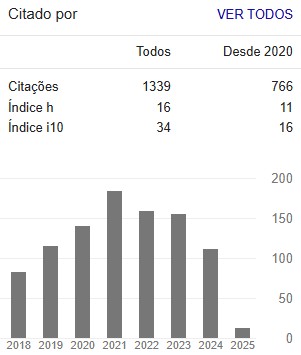EFFECTS OF MYOFASCIAL RELEASE IN TEMPOROMANDIBULAR DYSFUNCTION
Palavras-chave:
disfunção temporomandibular, síndrome da disfunção da articulação temporomandibular, dor miofascial, pontos-gatilhoResumo
The temporomandibular joint (TMJ), associated with factors that cause dental disharmony, such as wrong bites and stress, can affect the joint and progress to temporomandibular disorder (TMD). The objective was to evaluate the effects of manual techniques of myofascial release (LM) of the face and neck muscles in the quality of life and in the psychological conditions, during the beginning and end of the treatment. Participated in the study 15 participants, aged between 18 and 55 years, with signs and symptoms of TMD. The treatment consisted of LM associated with stretching and pomping techniques cervical, as well as health education. There was a significant reduction in the pain domain values and a significant increase in the SF-36 total score, indicating an improvement in quality of life. Regarding HADS, there were no significant changes.
Downloads
Referências
Richene, RV. Lamb, RS. Physiotherapeutic performance in temporomandibular joint disorders. Journal of Specialist. 2018;1(3): 2595-6256.
Urbani, G. Jesus, LF. Silva, ENC. Temporomandibular joint dysfunction syndrome and stress in police work: an integrative review. Revista Ciência & Saúde Coletiva. 2019; 24(5):1753-1765 https://doi.org/10.1590/1413-81232018245.16162017
Oliveira, CM. Brandao, LA. Miranda, MS. Amaral, PHM. Lima, VFR. Jurno, ME. Prevalence of signs and symptoms of temporomandibular disorders in migraineurs. Rev Med Minas Gerais. 2018;28(5): e-S280508. https://doi.org/10.5935/2238-3182.20180120
Fehrenbach, J. Silva, BSG. Brondani, LP. The association of temporomandibular disorders with orofacial pain and headache. Journal of oral investigations. 2018;7(2):69-78. https://doi.org/10.18256/2238-510X.2018.v7i2.2511
Coutinho, EM. Santos, KPR. Ferreira, EHB. Pinto, RGS. Sanchez, MO. Association between self-reported sleep bruxism and temporomandibular disorder in undergraduate students from Brazil. Skull. 2020;38(2): 91-98. https://doi.org/10.1080/08869634.2018.1495874
Reis, KS. Rocha, VA. Dantas, NB. Cantinho, KMCR. Gouveia, GPM. Carvalho, GD. Prevalence and factors associated with temporomandibular disorder in physiotherapy students: cross-sectional study. Research, Society and Development. 2021;10(5):e37710514984. https://doi.org/10.33448/rsd-v10i5.14984
Santos, NEB. Cavalcante, JGS. Silva, TRG. Santos, SCAV. Fernandes, EG. Piglet, AKA. Feitosa, VP. Use of low-level laser in the treatment of temporomandibular muscle dysfunction - a systematic review. Brazilian Journal of health Review, 2020;3(6):18331-18341. https://doi.org/10.34119/bjhrv3n6-231
Tortelli, SAC. Saraiva, L. Miyagaki, DC. Effectiveness of acupuncture, ozone therapy and low-level laser in the treatment of temporomandibular disorders of muscular origin: a randomized clinical trial. Rev. odontol. Unesp 2019;48:e20190107. https://doi.org/10.1590/1807-2577.10719
Souza, ACOC. Pereira, PC. Junior, JDC. (2020). The influence of low-level laser therapy and therapeutic ultrasound on mouth opening in patients with temporomandibular disorders. Articles Magazine. 2020; 22: e6006.
Silva, SEC. Santos, KLS. Raimundo, RJS. Physiotherapeutic intervention in the treatment of temporomandibular disorders: a systematic review. JRG Journal of Academic Studies. 2018;1(3):82-88.
Oliveira, APM. Pereira, KP. Felicio, LR. Evidence of the myofascial release technique in physical therapy: a systematic review. Arquivos de Ciências do Esporte, 2019;7(1):8-12. https://doi.org/10.17648/aces.v7n1.3504
Eng, J. Sample size estimation: How many individuals should be studied. Radiology, 2003;227(2): 309-13
https://doi.org/10.1148/radiol.2272012051
Haefeli, M. Elfering, A. Pain assessment. Eur Spine J. 2006;15(1):17-24. https://doi.org/10.1007/s00586-005-1044-x
Ciconelli, RM. Ferraz, MB. Santos, W. et al. Translation into Portuguese and validation of the generic quality of life questionnaire SF-36 (Brasil SF-36). Rev Bras Rheumatol. 1999;39(3):143-50.
Foger, D. Mamani, MP. Santos, PS. The impact of temporomandibular disorders on quality of life. Physioter. Mov. Curitiba. 2020;33: e003320. https://doi.org/10.1590/1980-5918.033.ao20
Botega, NJ. Bio, MR. Zomignani, MA. Garcia, JRC. Pereira, WAB. Mood disorders in a medical clinic ward and validation of a measurement scale (HAD) of anxiety and depression. Public Health Journal. 1995;29(5):355-63. https://doi.org/10.1590/S0034-89101995000500004
Medeiros, RA. Vieira, DL. Silva, EVF. Vincent, LVML. Santos, RW. Tabata, LF. Prevalence of symptoms of temporomandibular disorder, oral behaviors, anxiety and depression in dental students during the period of social isolation due to COVID-19. Journal of applied oral Science. 2020;28: e20200445. https://doi.org/10.1590/1678-7757-2020-0445
Poluha, RL. Grossmann, E. Iwaki, LCV. Uchimura, TT. Santana, RG. Iwaki Filho, L. Myofascial trigger points in patients with temporomandibular joint disc displacement with reduction: a cross-sectional study. Journal of applied oral science. 2018;26(0):e20170578. https://doi.org/10.1590/1678-7757-2017-0578
Leeuw, RD. Klasser, GD. Orofacial pain: guidelines for assessment, diagnosis, and management. Vol Fifth edition. United States: Chicago: Quintessence Publishing Co, Inc. 2013.
Apfelberg, DB. Lavey, E. Janetos, G. Maser, MR. et al. Temporomandibular joint disease: results of a ten-year study. Postgraduate Medicine. 1979;65(5):167-169, 171-162. https://doi.org/10.1080/00325481.1979.11715147
Nahian, A. ÜNal, M. Mathew, JrJ. Osteopathic Manipulative Treatment: Facial Muscle Energy, Direct MFR, and BLT Procedure – for TMJ Dysfunction. StatPearls. Treasure Island (FL): StatPearls Publishing Copyright. 2022, StatPearls Publishing LLC.; 2022
Kuć, J. Szarejko, KD. Gołębiewska, M. Evaluation of Soft Tissue Mobilization in Patients with Temporomandibular Disorder-Myofascial Pain with Referral. International Journal Of Environmental Research And Public Health. 21 2020;17(24). https://doi.org/10.3390/ijerph17249576
Trize, DM. Calabria, MP. Franzolin, SOB. Cunha, CO. et al. Is quality of life affected by temporomandibular disorders. Einstein. 2018;16(4):eAO4339. https://doi.org/10.31744/einstein_journal/2018AO4339
Bitiniene, D. Zamaliauskiene, R. Kubilius, R. Leketas, M. et al. Quality of life in patients with temporomandibular disorders. The systematic review. Stomatology. 2018;20(1):3-9.
Gesslbauer, C. Vavti, N. Keilani, M. Mickel, M. et al. Effectiveness of osteopathic manipulative treatment versus osteopathy in the cranial field in temporomandibular disorders - a pilot study. Disability And Rehabilitation. 2018;40(6):631-636. https://doi.org/10.1080/09638288.2016.1269368
Soares, LFF. Coelho, LM. Moreno, A. Almeida, DAF. Haddad, MF. Anxiety and depression associated with pain and discomfort from temporomandibular disorders. BJP 2020;3(2). https://doi.org/10.5935/2595-0118.20200029
Golanska, P. Saczuk, K. Domarecka, M. Kuć, J. et al. Temporomandibular Myofascial Syndrome Pain-Aetiology and Biopsychosocial Modulation. The Narrative Review. International Journal Of Environmental Research And Public Health. 2021;18(15):7807-23. https://doi.org/10.3390/ijerph18157807
Downloads
Publicado
Edição
Seção
Licença
Os artigos submetidos à revista Colloquium Vitae estão licenciados conforme CC BY-NC-ND. Para mais informações sobre essa forma de Licenciamento, consulte: http://creativecommons.org/licenses/by-nc-nd/4.0/.
A disponibilização é gratuita na Internet, para que os usuários possam ler, fazer download, copiar, distribuir, imprimir, pesquisar ou referenciar o texto integral dos documentos, processá-los para indexação, utilizá-los como dados de entrada de programas para softwares, ou usá-los para qualquer outro propósito legal, sem barreira financeira, legal ou técnica.

